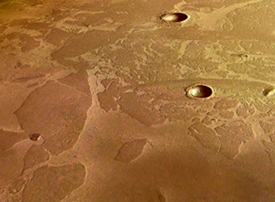Mars Express science highlights:
#2. Possible detection of methane in the atmosphere
When the PFS began taking data, soon after Mars Express entered orbit around the Red Planet on December 2003, the instrument team saw a puzzling signal. As well as the atmospheric gases they were anticipating, such as carbon monoxide and water vapour, they also detected tiny amounts of methane – a molecule made up of four atoms of hydrogen bound to a carbon atom.
Since the methane molecule is not stable in the martian atmosphere, it should only exist for a few hundred years – unless it is replenished in some way. Although the primary candidate as the source was volcanic activity, another, equally exciting, possibility was active 'biological' processes. On Earth, living organisms release much of the planet’s methane as they digest nutrients, and methane is the main component of natural gas.
The mystery was enhanced by the PFS observation that areas with the highest concentrations of methane overlapped with areas of higher water vapour levels in the atmosphere and underground water ice.
 |
|
Part of Elysium Planum - one of the regions where tiny amounts of methane appeared to be detected. Credit: ESA/DLR/FU Berlin (G. Neukum) |
PFS found that, close to the surface, water vapour levels were enhanced two to three times in three broad equatorial regions: Arabia Terra, Elysium Planum and Arcadia-Memnonia. These locations corresponded to the areas where NASA's Mars Odyssey spacecraft had observed a layer of water ice a few tens of centimetres below the surface.
This spatial correlation between water vapour and methane seemed to point to a common underground source – such as geothermal heating associated with active volcanism, or biological activity.
A further twist to the methane mystery came in 2009, when scientists developing atmospheric models claimed that the observed variations of methane on Mars cannot be explained by known atmospheric chemistry and physics.
The ongoing debate will have to wait until a future mission, the ExoMars Trace Gas Orbiter, which is scheduled for launch in January 2016. The spacecraft will be able to measure trace levels of methane and other hydrocarbons, and check their isotopic make-up for signs of biological or geological activity.
